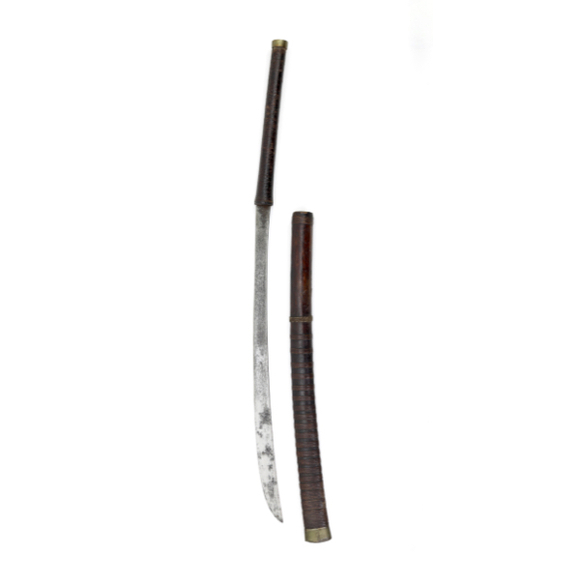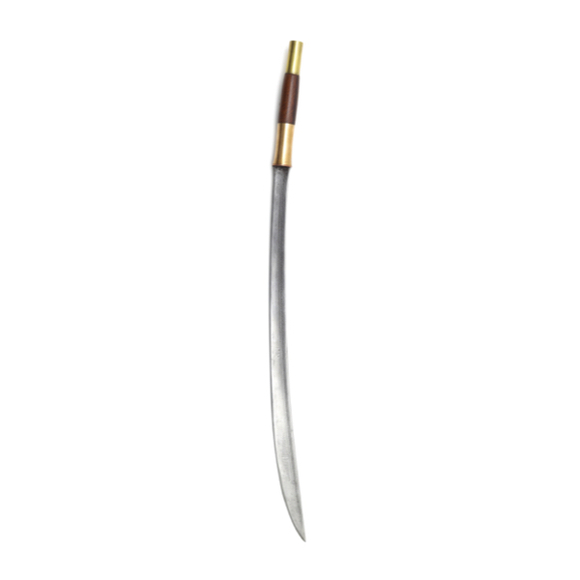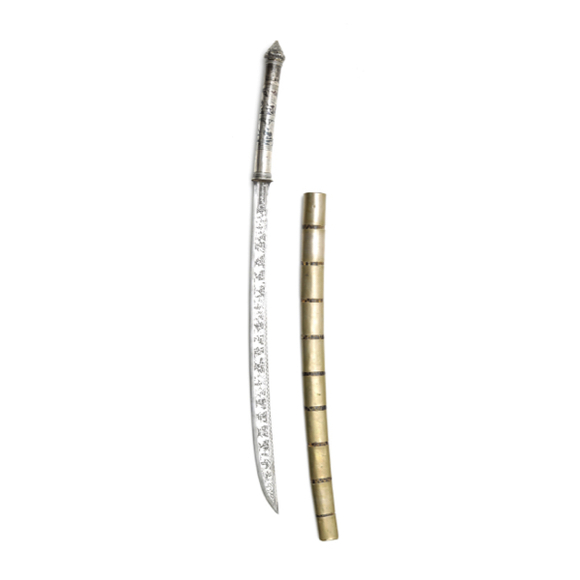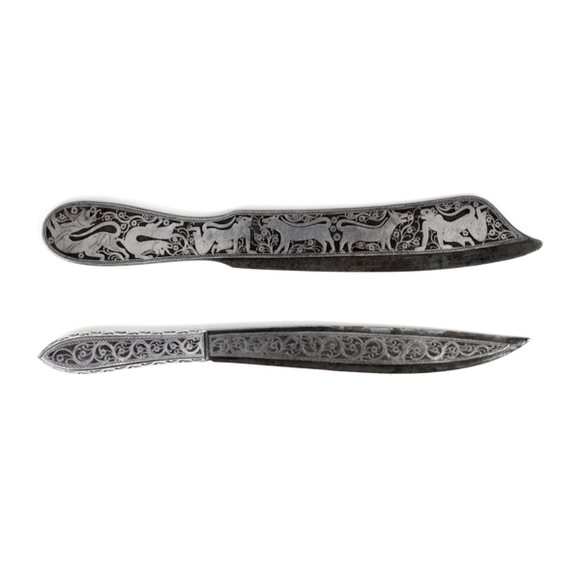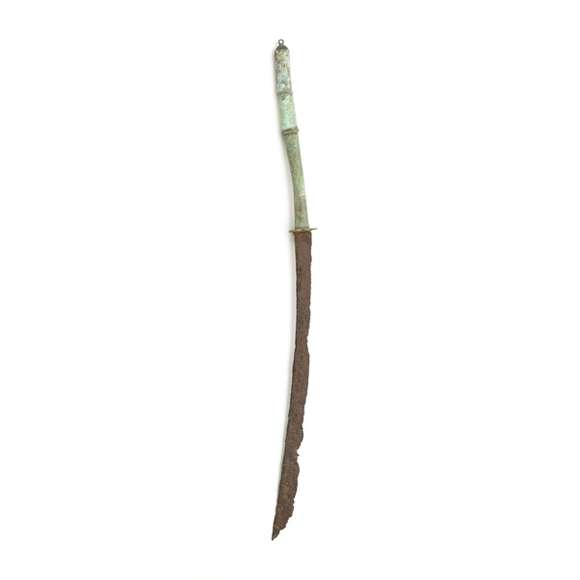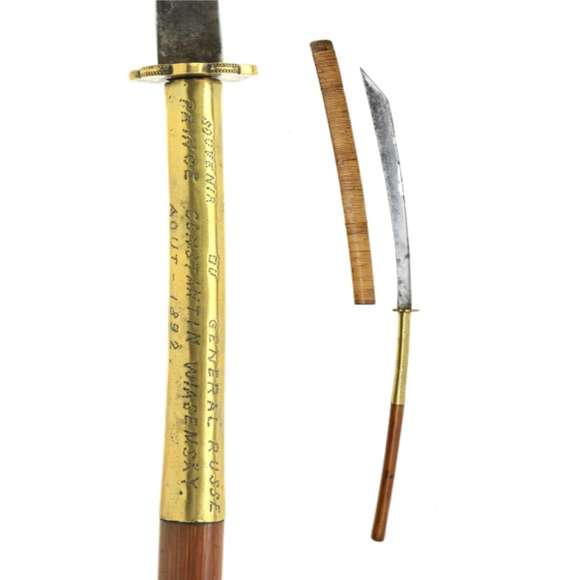Of a type likely produced by the Shan people and traded widely in the region.

73 cm
51 cm
Base 7 mm
Middle 5 mm
Near tip 4 mm
Base 26 mm
Middle 26.5 mm
Widest 29 mm
522 grams
10.8 cm from hilt
Burma (Myanmar)
Iron, steel, wood, silver, ivory, plant fiber, silk, precious stone possibly ruby
Introduction
According to a monograph of 1900, Burmese ivory carving saw its height between 1870 and 1900. Two rival families of carvers claimed to have invented the craft in recent times, while some legends suggest much earlier origins.
The best carving in ivory was done in Moulmein (Mawlamyine) in the southern stretch of Burma with some "fairly good work" done in Pyinmana in central Burma. There had also been a carver active in Rangoon (Yangon), but by 1900 he had retired and outsourced orders to Moulmein.1
The entire industry in Moulmein consisted of only 8-12 tusks a year.
In Moulmein, the ivory is procured chiefly from Shan traders and occasionally from the local timber mills, or the Commissariat Department when an elephant happens to die or break its tusks.2
Apparently, all ivory carving was done on special order:
Articles are not manufactured in anticipation of the demand, but solely to meet orders received.3
This example
A somewhat short Burmese dha with an ivory hilt. The steel blade of typical form, narrow and with a gradual widening towards the tip section and a false backedge running about 2/3rd of the blade length. A narrow groove on either side is crosshatched and decorated with scrollwork in silver wire. According to Bell, such swords were made much like Japanese swords with an outer casing of steel around a softer iron core.4
Hilt
The hilt consists of an ivory grip section with silver pommel and silver ferrule. Pommel and ferrule are both worked in repousse in traditional Burmese floral designs, the back of the pommel is decorated with a large star and five smaller stars surrounding it.
The grip section is finely carved with a tall, bearded figure holding his long mustache. Above his head is another face that appears to wear the pommel as a hat. It has what appear to be ruby eyes.5
At the back of the grip section is another seated figure, the rest of the decoration is floral in nature.
Scabbard
The wooden scabbard is entirely clad in silver, consisting of six segments with ribbed bands covering the seems. The surface is engraved with Burmese floral designs around a series of cartouches on either side. At the top of the scabbard is a plant fiber cord, covered with deep green silk velvet.
Conclusion
A charming Burmese dha that makes use of high-end materials and decorative elements, while none of the work represents the best of what the more metropolitan Burmese craftsmen could do. I, therefore, believe it was probably the sword of some local chief, or otherwise a Burmese of some means and status but in a smaller, rural community.
The ivory carving has a nice strong presence yet not the fine carving described as being done in Moulmein. Perhaps this is an example of the work done in Pyinmana.
Notes
1. H.S. Pratt, I.C.S.; Monograph on Ivory Carving in Burma, Rangoon, Printed by the Superintendent, goverment Printing Burma, 1901. (Written in 1900.)
2. Ibid.
3. Ibid.
4. E.N. Bell I.C.S.; A Monograph on Iron and Steel Work in Burma. Rangoon, Superintendent, Government Printing Burma, 1907.
5. Given the fact that 90% of the world's rubies come from Burma's "Valley of the Rubies" in Mogok, these might actually be rubies.
CITES
To meet the demands of the Convention International Trade of Endangered Species (CITES), this object is sold with an appraisal document from a certified Dutch appraiser of the TMV Federation. Among others, it states that the item is manufactured in the 19th century. The handle is of ivory of the species Elephas Maximus, listed on CITES appendix I.
The item is within article 2 of council regulation EC NO338/97 and within Convention of International Trade of Endangered Species (CITES): The materials were removed from the wild and significantly altered from their natural state well before the date of the convention: June 1st, 1947. It can be freely traded within the EU without a permit and is eligible for a CITES export permit for trade outside of the EU.
Buyers outside of Europe: Beware that it may not be possible to export the item to your country due to restrictions on international ivory trade. CITES sets the minimal restrictions, countries, and states under the convention often maintain further restrictions on top of CITES. I will be happy to advise.













Fine silver overlaid dha made in Mindan village, south of Mandalay, gained fame in the 19th…
Collected by a Russian prince from the hill peoples of central Vietnam in 1892.

